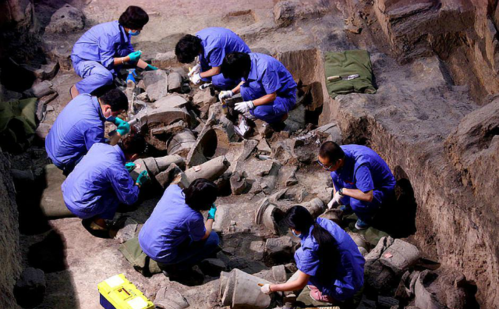
Have the Terracotta Warriors Been Fully Excavated?
The Terracotta Army, a vast collection of life-sized terracotta figures buried with Qin Shi Huang, the first emperor of China, is one of the world's most renowned archaeological wonders. Since their discovery in 1974, these figures have captivated the globe, offering a glimpse into ancient Chinese civilization. However, a question often arises: have all of the Terracotta Warriors been unearthed?
The answer, in short, is no.
The Four Pits and Their Contents
To date, archaeologists have identified four distinct pits at the burial site, each serving a unique purpose:
- Pit 1: The largest of the four, Pit 1 contains the main army formation. Rows upon rows of infantry, archers, and charioteers stand in battle formation, facing east, ready to protect their emperor in the afterlife. This pit alone is estimated to hold over 6,000 figures.
- Pit 2: This pit houses a mixed force of cavalry, infantry, and war chariots, reflecting the complexity and might of the Qin army. Archaeologists believe Pit 2 represents a military guard and strike force, ready to deploy at a moment's notice.
- Pit 3: Smaller than Pits 1 and 2, Pit 3 contains high-ranking officers and command chariots, showcasing the army's chain of command. This pit offers valuable insights into the military structure and hierarchy of the Qin dynasty.
- Pit 4: Unlike the other pits, Pit 4 is empty. This is believed to be due to the unfinished construction of the mausoleum complex, potentially halted due to rebellion following the emperor's death.
The Scale of the Unexcavated
While excavations have been ongoing for decades, only a fraction of the Terracotta Army has been unearthed.
- Estimated Figures: Experts estimate that the four pits may contain up to 8,000 figures, with thousands still buried underground.
- Preservation Concerns: Excavating and preserving these ancient figures is an intricate and time-consuming process. Exposure to air and light can cause rapid deterioration, demanding meticulous conservation efforts.
- Technological Advancements: Archaeologists are constantly developing new technologies and techniques for excavation and preservation, allowing for a more controlled and sustainable approach.
The Mystery Remains
The incomplete excavation of the Terracotta Army leaves us with intriguing questions about the vastness of the site and the secrets it still holds.
- Will the full army ever be excavated? It's uncertain. Balancing archaeological preservation with historical discovery presents a continuous challenge.
- What else lies buried with the emperor? The vastness of the mausoleum complex suggests that the Terracotta Army may be just one element of an even grander burial site. Further discoveries may await, offering further insight into this pivotal period in Chinese history.
FAQs
Q: Why were the Terracotta Warriors buried with the emperor?
A: The Terracotta Army was intended to serve as a symbolic army for Qin Shi Huang in the afterlife, reflecting the belief in a spirit world and the desire for power and protection even after death.
Q: How were the Terracotta Warriors made?
A: The figures were crafted using terracotta clay, a porous material commonly found in the region. Each warrior was individually sculpted and outfitted with unique features, armor, and weaponry, showcasing the craftsmanship of the time.
Q: Why is the fourth pit empty?
A: The empty Pit 4 suggests that the construction of the mausoleum complex was halted prematurely, possibly due to political upheaval or rebellion following the death of Qin Shi Huang.